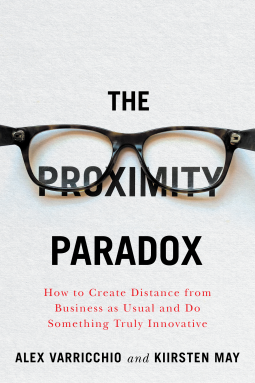
The Proximity Paradox
How to Create Distance from Business as Usual and Do Something Truly Innovative
by Kiirsten May; Alex Varricchio
This title was previously available on NetGalley and is now archived.
Buy on Amazon
Buy on Waterstones
*This page contains affiliate links, so we may earn a small commission when you make a purchase through links on our site at no additional cost to you.
Send NetGalley books directly to your Kindle or Kindle app
1
To read on a Kindle or Kindle app, please add kindle@netgalley.com as an approved email address to receive files in your Amazon account. Click here for step-by-step instructions.
2
Also find your Kindle email address within your Amazon account, and enter it here.
Pub Date 24 Mar 2020 | Archive Date 1 Nov 2019
Talking about this book? Use #TheProximityParadox #NetGalley. More hashtag tips!
Description
The Proximity Paradox will show you how to step back from your business to focus your creativity and meet your clients’ needs
“Innovative … It’s a much-needed perspective on how to escape inside-the-box thinking.” — Publishers Weekly
Traditional business structures love stability and predictability. Yet many organizations believe the two essential ingredients for long-term success are creativity and innovation. Kiirsten May and Alex Varricchio, founders of the marketing agency UpHouse, call the relationship between these two opposing expectations the Proximity Paradox™ — the belief that those who are closest to a subject are best qualified to innovate for it when, in reality, intense proximity limits creativity. Instead, people need to create distance from challenges in order to see the best way forward. May and Varricchio believe that until we can separate innovation and execution within ourselves, we will only innovate to the level at which we can execute the idea. To be effective, we need to create distance between our innovation brain and our execution brain.
Unpacking ten common examples of the Proximity Paradox that affect a company’s people, processes, and industry, the authors share some practical ideas to create the distance necessary for your next great idea. An especially valuable book for creatives, and non-creatives in creative industries, but equally applicable to all businesses that depend on innovation, The Proximity Paradox encourages us to ask hard questions about how we work, how our businesses are structured, and why we routinely find our creativity at odds with what’s asked of us as executors and stewards of the bottom line.
“Innovative … It’s a much-needed perspective on how to escape inside-the-box thinking.” — Publishers Weekly
Traditional business structures love stability and predictability. Yet many organizations believe the two essential ingredients for long-term success are creativity and innovation. Kiirsten May and Alex Varricchio, founders of the marketing agency UpHouse, call the relationship between these two opposing expectations the Proximity Paradox™ — the belief that those who are closest to a subject are best qualified to innovate for it when, in reality, intense proximity limits creativity. Instead, people need to create distance from challenges in order to see the best way forward. May and Varricchio believe that until we can separate innovation and execution within ourselves, we will only innovate to the level at which we can execute the idea. To be effective, we need to create distance between our innovation brain and our execution brain.
Unpacking ten common examples of the Proximity Paradox that affect a company’s people, processes, and industry, the authors share some practical ideas to create the distance necessary for your next great idea. An especially valuable book for creatives, and non-creatives in creative industries, but equally applicable to all businesses that depend on innovation, The Proximity Paradox encourages us to ask hard questions about how we work, how our businesses are structured, and why we routinely find our creativity at odds with what’s asked of us as executors and stewards of the bottom line.
Available Editions
| EDITION | Other Format |
| ISBN | 9781770415324 |
| PRICE | US$18.95 (USD) |



